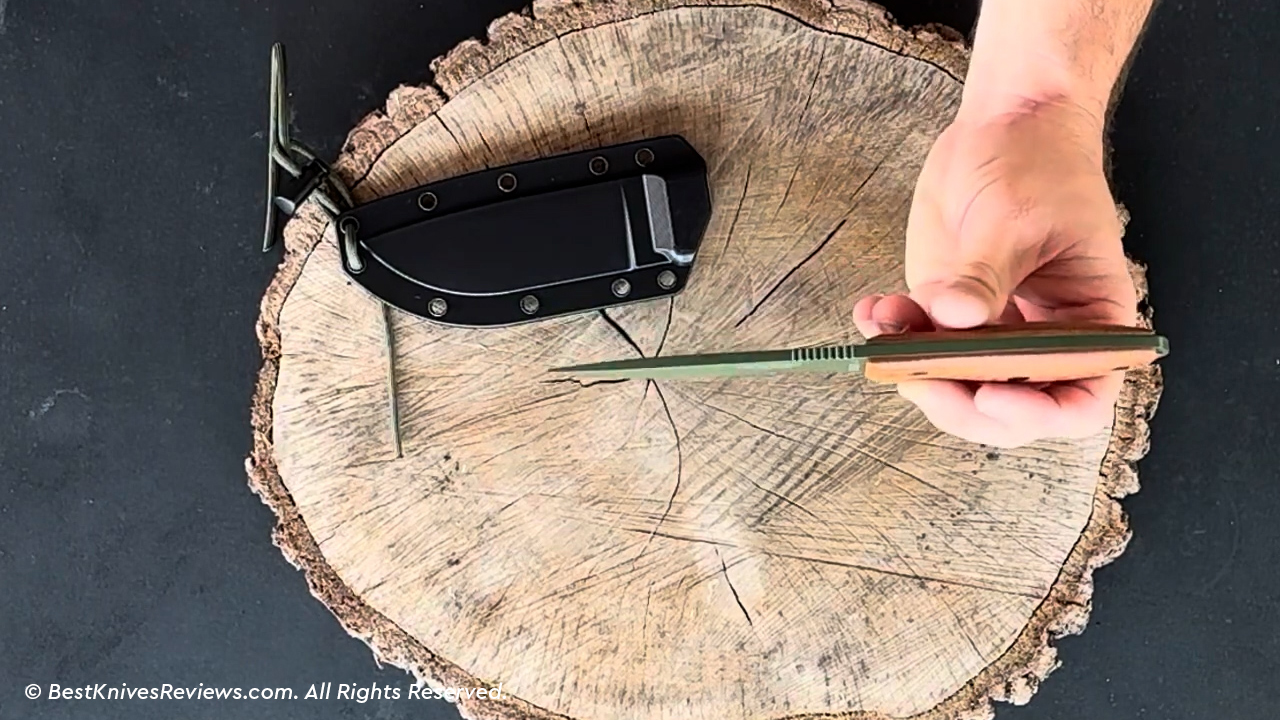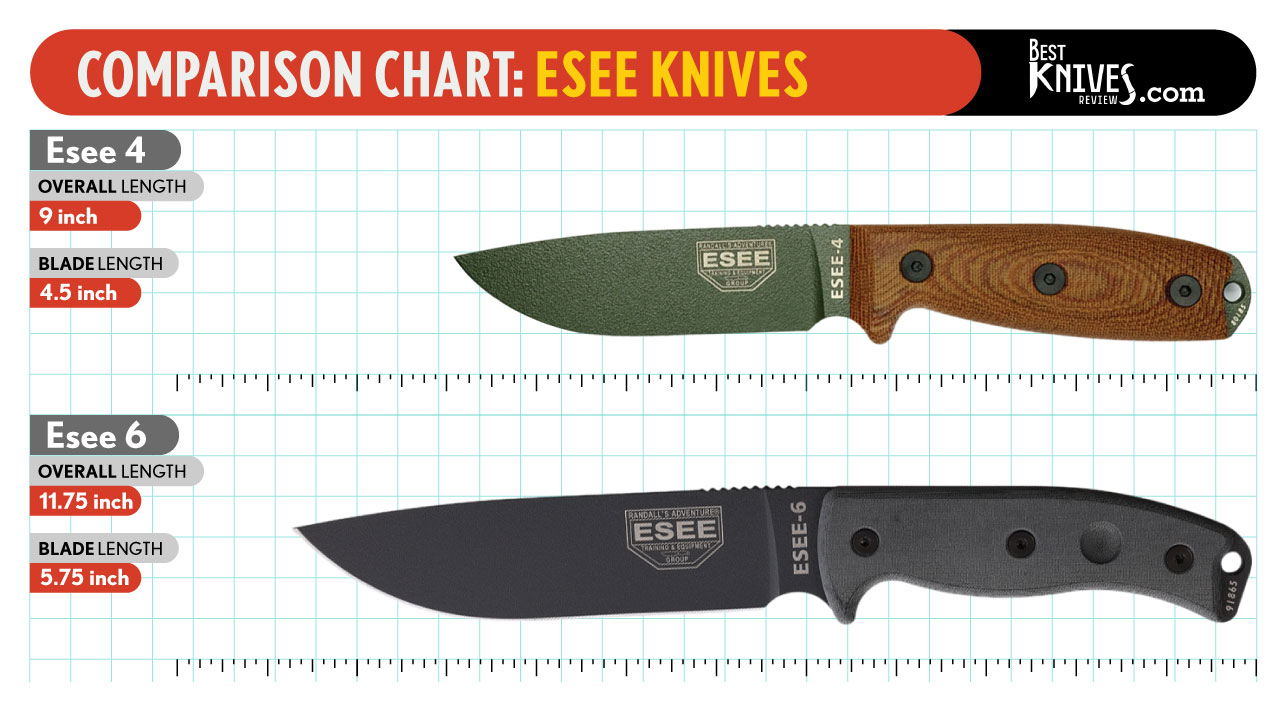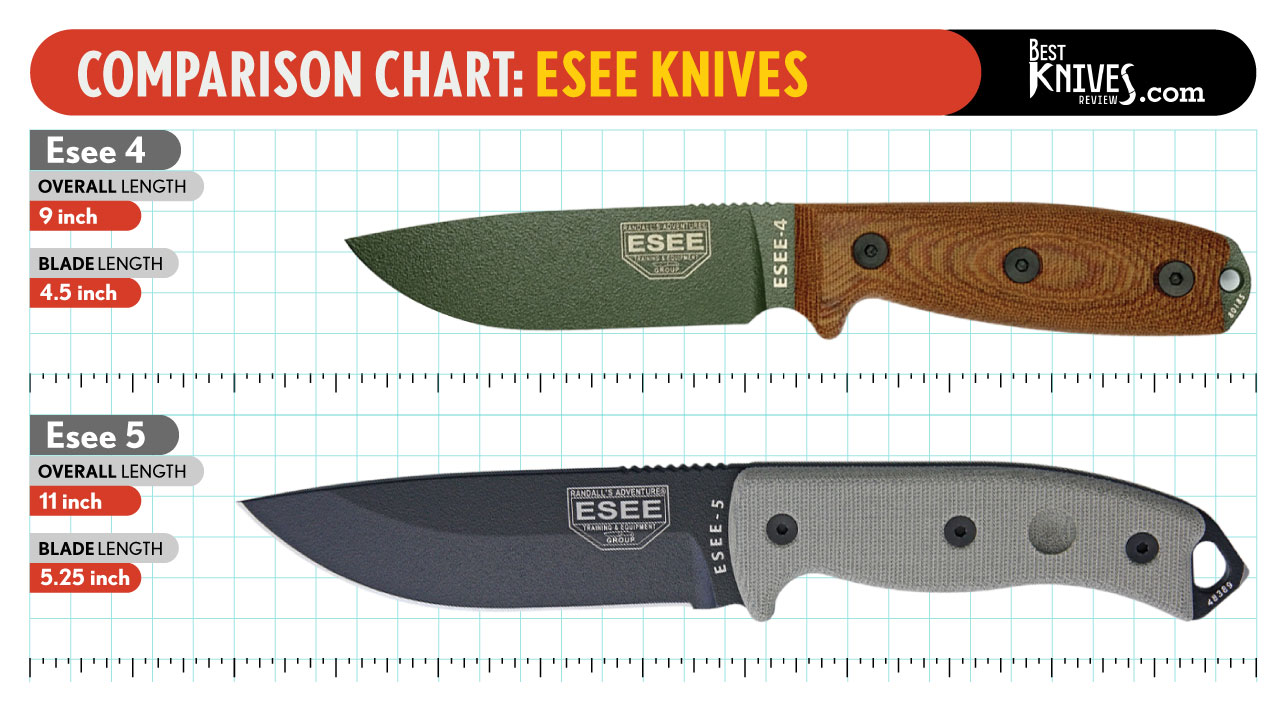ESEE 4 is a customizable survival, camping, and hunting gear knife. ESEE has been making their knives easy to modify by offering different blade, handle, and sheath options for all its designs. This customizable ability is what makes the ESEE 4 fun to own.
ESEE 4 Review

ESEE 4 is a 9” fixed-blade knife with extended tang and a lanyard hole that comes with black molded plastic belt sheath. It features 4.5” OD Green powder coated 1095HC (High Carbon) steel with 55-57RC with a blade stock thickness of 0.188” and 4.1” cutting edge. It is a full flat ground drop point blade with a large choil and weighs 7.45 ounces without sheath and 12.25 ounces with sheath.
Its handle is made of natural canvas Micarta of 4.5” length.
Key Specifications of ESEE 4
First Impressions of ESEE 4


The ESEE 4 came in a very nice multi-layered packaging in shipment with all the labels intact. It has a nice branded cardboard box that included all the necessary items. The packaging and delivery very much matched the price of this knife.
The box contained the specifications of the knife, a manual that contained instructions on how and when to use the knife including necessary precautions, and the ESEE warranty card. ESEE offers unlimited and unconditional lifetime warranty on all its knives, which makes it a very compelling purchase. It also came with some ESEE stickers that you can use if you are a big ESEE fan. It helps promote brand loyalty as ESEE has a wide customer base.

The knife itself came locked inside the plastic belt sheath, which was inside the plastic sleeve. The belt clip also came separately, showing that it is removable and portable in case you do not want to add weight to the knife while carrying it. It also depends on how you want to carry it. You can solely use the belt as well to tie it to your belt.
But the clip makes it easier to latch it on to the belt, and it is ambidextrous. So it is better to use it with the sheath. It also comes with a paracord that you can use on the knife’s lanyard hole.
The knife easily slides out of the sheath with a fine green powdered costing. The grind lines are clearly visible. And although it does not have a razor-sharp factory edge, it does a fine cutting job. The spine of the blade is also quite thick, which makes it a star for batoning, although the 4.1” cutting edge may not be long enough for that. The choil is also large enough to make sharpening it easier. But it can lose it edge easily because of the soft heat treatment.
The handle felt smooth and comfortable in the hand with enough bend below the spine that acts as a finger guard. The Micarta 3D handle had a soft layer, and with the natural finish, it can retain its texture. The full tang further makes the knife durable and capable under harsh conditions. The large screws are strategically place and do not protrude out. They are completely submerged in the handle.
The knife states ‘ESEE 4’ horizontally across the blade’s spine with the ESEE logo etched vertically above on the blade. It also has a profound lanyard hole.
The Blade of ESEE 4


The blade of ESEE 4 features a large choil that makes sharpening and reconditioning the edge easier than with a nonexistent choil. The full flat ground drop point cutting edge of 4.1” makes it an excellent EDC knife. It also has a fine blade geometry that can be used as an all-purpose knife. It also has enough width of 0.25” and belly to made precise slicing and dicing effortless. These properties also makes this knife an excellent chef’s knife for outdoor kitchen use and food preparation. The cutting edge near the rear of the spine dissipates energy as the cutting stroke approaches the object to be cut. This means that you can also chop using a chopping board. It also helps exercise control over the tip, which is useful during skinning and other survival tasks.
The drop point further adds strength to the tip of the blade. That combined with the thicker flat spine makes it an excellent option for batoning. However, drop point may not be as suitable for piercing as spear point, tanto, and other blade styles can be.
The 1095 high carbon steel on ESEE 4 makes it an excellent bushcraft/survival gear. Although it is prone to rust, the OD green powder finishing protects it. Its non-reflective finish makes it corrosion resistant, adds aesthetic appeal and reduced glare. It also keeps the blade dry yet lightly lubricated.
The Handle and Ergonomics of ESEE 4

ESEE is known for making ergonomically friendly knife handles, and so is the case with ESEE 4. The natural canvas Micarta makes for a very well-refined handle scale, providing a solid grip whether it is wet or dry.
It fits very well in the hand, and you can also use the lanyard to extend its length if you have large hands. But it will fit just fine regardless. The large choil beneath the handle serves as an additional finger groove, allowing you to choke up the knife for fine blade manipulation.
The jimping along the spine also allows you to hold the knife more comfortably for an extended period and allows a level of control for the thumb-supported cutting and allows you to extend it forward and fully utilize the cutting edge.
The handle is screwed together with three large solid screws built in place, keeping the knife secure and tight.
The Sheath of ESEE 4
The black molded plastic belt sheath may not be as good as the Kydex sheath, but it is ambidextrous so you can wear it on either side. It can break under certain conditions, but works well for the most part. It also locks the blade into place, so it would not slide out without force. It also completely obscures all the edges of the knife to make it safe to carry. You can wear it on your belt or your backpack, or you can use the belt to tie it anywhere you want.
You can also use the belt of the sheath as a lanyard for the ESEE 4 handle. It will fit easily and serve its purpose. It also had drain holes, making it easier to wash and maintain.
However, if you are not too happy with the plastic sheath, you can separately purchase the MOLLE back sheath. It is superior in quality and will hold up longer. It will cost more than the standard sheath, but it depends on the user. If you intend to carry the ESEE 4 under harsh conditions and use it frequently, then it would be better to get the MOLLE sheath. Otherwise, the plastic sheath will work for occasional use.
Field Test of ESEE 4
Taking the ESEE 4 into the field revealed that the knife is durable but compromises at its cutting ability. It makes fine feather sticks, but takes a bit of trial and error to get decent wooden curls enough to start a fire.
The factory edge is not as sharp, but is easy enough to fix. It is not a great slicer even after you sharpen it because the blade spine is too wide. That makes the shavings too thick. Convex grind bushcraft knives make better feather sticks as opposed to drop point, which is better suited for EDC and kitchen tasks. It works finer with softer wood though.
You can also do skinning with this knife, cook an outdoor meal while performing food preparation tasks and start a fire. But the blade will take some time.
ESEE 4 however, does not do well on paper cutting task. It will require some major blade reshaping. We also found that the blade is easier to sharpen while in the field. If you frequently use the ESEE 4 for survival tasks, its edge will take time and care to maintain.
The green OD powder coating keeps the knife from throwing sparks off a ferro rod. The coating keeps the blade from rusting, but does not help in starting a fire easily. We also expected the coating to come off due to hard use, but it did not. You can also work towards removing the coating if it interferes with the survival tasks and the fire starter. Many people do that in order to exercise control over their knives. ESEE has also started making knives in several different variations, including naked steel.
Overall, the ESEE 4 does a bit of everything, including survival tasks, camping, outdoor cooking and skinning. It lacks in its fire starting abilities and a sharp edge, but does the tasks well.
The ambidextrous sheath with a clip and belt also does a fine job of making it easier to carry however you would like.
Pros & Cons of Esee 4
PRO’s
Con’s
ESEE 4 vs ESEE 6

The ESEE 4 and 6 are both fixed-blade bushcraft/survival knives, but have different strengths and weaknesses. The ESEE 4 is able to carry all knife tasks, while ESEE 6 is better at batoning wood and tasks that require a larger knife, since it is 11.75” long. Its length and weight balance is what keeps it from becoming a great knife.
The ESEE 6 is stronger and more resilient when used as a camping and survival knife. ESEE 4 is thicker yet lightweight with the Micarta handle. Its blade is also wider than ESEE 6’s.
However, they both have a finger choil and guard that makes sharpening easier and prevents the finger from sliding under the blade. ESEE 6 costs more because it is the newer model.
When it comes down to the two knives, it really depends on how you intend to use them and how much you are willing to pay. Each knife has its own pros and cons.
ESEE 4 vs ESEE 5

ESEE 4 and 5 are both good for woodcutting, camping, hunting, and survival tasks. They are the same in terms of handle, blade steel and design, but differ in size. ESEE 5 is longer with more blade thickness than ESEE 4. It is also more suitable for heaver survival tasks like batoning.
ESEE 4 may be smaller, but has better edge retention and hardness level. That also makes the knife suitable for precision work like skinning.
Both the knives are low corrosion resistant and come with a finger choil and thumb spine. They both also have non-slippery, smooth yet comfortable Micarta handle.
While ESEE 4 comes with a molded black plastic sheath, the ESEE 5 comes with a Kydex sheath with a clip plate, which is a better alternative to the plastic sheath.
Conclusion Esee 4
ESEE 4 is a large fixed-blade full tang knife with a lanyard hole and comes with a molded plastic belt sheath. It is a bushcraft/survival, camping, and hunting knife that is capable of skinning, slicing feather sticks and do camping and hunting tasks. However, it lacks a sharp factory edge and edge retention as compared to ESEE 5. Its cutting edge can also feel a bit longer for precise cuts. And although the 1095 steel is hard and corrosion resistant, the green OD coating can interfere in exercising control over the knife. It also has a choil that makes sharpening easier. It takes some trial and error to slice thin and fine feather sticks, but it cannot spark a ferro rod. That makes it less of an outdoor/survival knife.
The natural canvas Micarta handle is non-slippery yet smooth and comfortable in the hand with a finger guard. The knife comes with a black plastic molded sheath that secures the blade in place well. It also comes with a belt that can be used as a paracord in the lanyard hole. However, the plastic sheath is not very durable and can be replaced by MOLLE sheath. It will cost more but will last longer.
